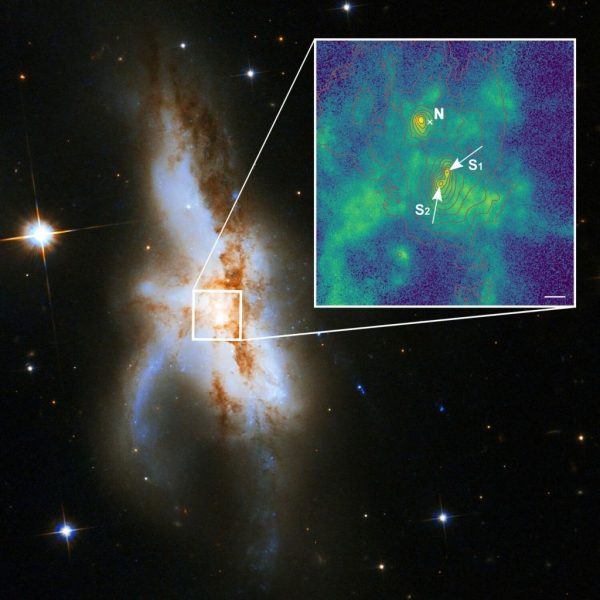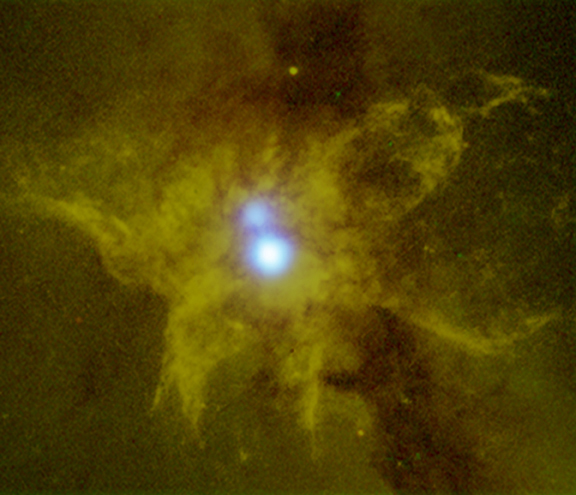Astronomers Find a Galaxy Containing Three Supermassive Black Holes at the Center – Universe Today
NGC 6240 is a puzzle to astronomers. For a long time, astronomers thought the galaxy is a result of a merger between two galaxies, and that merger is evident in the galaxy’s form: It has an unsettled appearance, with two nuclei and extensions and loops.
NGC 6240 is about 400 million light years away, in the constellation Ophiuchus. Even though it’s been studied intensely, it’s a very dusty place, and certain details have been obscured. But a new study using the European Southern Observatory’s (ESO) Very Large Telescope (VLT,) along with the advanced 3D MUSE Spectrograph, has opened up a new window into NGC 6240, and revealed a big surprise.
The galaxy is the result of not two galaxies merging, but three. And as a result, it’s home to not two supermassive black holes, but three.
“Up until now, such a concentration of three supermassive black holes had never been discovered in the universe.”
Dr Peter Weilbacher, Leibniz Institute for Astrophysics.
The MUSE spectrograph is a visible light spectrograph with both a wide field of view and excellent spatial resolution, thanks to adaptive optics. It’s what’s known as a panoramic integral-field spectrograph. It saw first light in 2014, and is optimized for studying a wide variety of objects, including supermassive black holes in nearby galaxies. Astronomers used MUSE’s power to peer into NGC 6240 with more precision than ever before, revealing the three supermassive black holes.

An international team of scientists produced this new research, led by scientists from Gottingen and Potsdam. The study is published in the journal Astronomy and Astrophysics. Their paper is titled “A triple nucleus system in the advanced or final state of merging.”
“Through our observations with extremely high spatial resolution we were able to show that the interacting galaxy system NGC 6240 hosts not two – as previously assumed – but three supermassive black holes in its centre,” said Professor Wolfram Kollatschny from the University of Göttingen, the lead author of the study.
“Up until now, such a concentration of three supermassive black holes had never been discovered in the universe,” adds Dr Peter Weilbacher of the Leibniz Institute for Astrophysics Potsdam (AIP). “The present case provides evidence of a simultaneous merging process of three galaxies along with their central black holes.”

This study could be part of a missing link in our understanding of how galaxies form. The largest, most massive galaxies in the universe are a bit of a puzzle. Our understanding of how they form can’t explain the largest ones. There hasn’t been enough time in the approximately 14 billion year age of the universe for the most massive galaxies to form, even taking into account the merging of two galaxies.
But if three galaxies can merge simultaneously, like NGC 6240 has, then that goes a long way towards explaining the existence of enormous galaxies.
“If, however, simultaneous merging processes of several galaxies took place, then the largest galaxies with their central supermassive black holes were able to evolve much faster,” said Peter Weilbacher in a press release. “Our observations provide the first indication of this scenario.”
The MUSE spectrograph’s capabilities made this discovery possible. Not only is it mounted on the 8-meter VLT with adaptive optics, which gives it a sharpness similar to the Hubble Space Telescope, but it creates a spectrum for each single pixel in the image. That power allowed it to peer into the dust and resolve the southern black hole into two separate black holes.

NGC 6240 is likely near the end of its merging process, which can take over a billion years to conclude. Each of the supermassive black holes has more mass than 90 million Suns, and eventually all three of these black holes will merge into one massive behemoth. When that happens, some time in the distant future, that merger will create powerful gravitational waves.
More:
- Press Release: The simultaneous merging of giant galaxies
- Research Paper: NGC 6240: A triple nucleus system in the advanced or final state of merging
- VLT Muse




